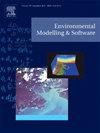基于动态地理图神经网络的PM2.5时空预测
IF 4.8
2区 环境科学与生态学
Q1 COMPUTER SCIENCE, INTERDISCIPLINARY APPLICATIONS
引用次数: 0
摘要
随着人们对数据驱动方法的兴趣日益浓厚,图神经网络(gnn)作为一种深度学习架构在PM2.5预测中表现出了强大的性能。然而,基于gnn的方法通常仅根据站点之间的距离构建图,很少有方法引入显著影响PM2.5空间弥散的地理因素,从而导致性能瓶颈。此外,这些方法往往不能全面处理动态风场数据,导致PM2.5弥散图构建不准确。这些缺点极大地限制了GNN模型在预测空气污染方面的可解释性。为了解决这些问题,我们提出了一种将图卷积网络(GCN)与长短期记忆(LSTM)相结合的深度学习方法,利用动态图中的地理信息。该模型使用从风场数据导出的动态方向图和表示固有地理关系的静态图来捕获PM2.5监测站之间的空间依赖关系。GCN和LSTM的结合可以同时提取空间和时间相关性。实验结果表明,我们提出的模型具有很强的可解释性,优于最先进的方法,特别是在24、30和36小时的预测中。本文章由计算机程序翻译,如有差异,请以英文原文为准。
Spatiotemporal PM2.5 forecasting via dynamic geographical Graph Neural Network
With the growing interest in data-driven methods, Graph Neural Networks (GNNs) have demonstrated strong performance in forecasting as a deep learning architecture. However, GNN-based methods typically construct the graph based solely on the distance between stations, and few methods introduce geographical factors that significantly affect the spatial dispersion of , leading to performance bottlenecks. Additionally, these methods often fail to process the dynamic wind–field data comprehensively, resulting in inaccurate dispersion graph construction. These shortcomings greatly limit the interpretability of GNN models in forecasting air pollution. To address these issues, we propose a deep learning method that combines Graph Convolution Network (GCN) with Long Short-Term Memory (LSTM), leveraging geographical information within a dynamic graph. The model captures spatial dependencies between monitoring stations using a dynamic directional graph derived from the wind–field data and a static graph to represent inherent geographical relationships. The combination of GCN and LSTM enables the extraction of both spatial and temporal correlations. The results of experiments suggest that our proposed model, which offers great interpretability, outperforms state-of-the-art methods, especially in 24, 30, and 36 hours forecasts.
求助全文
通过发布文献求助,成功后即可免费获取论文全文。
去求助
来源期刊

Environmental Modelling & Software
工程技术-工程:环境
CiteScore
9.30
自引率
8.20%
发文量
241
审稿时长
60 days
期刊介绍:
Environmental Modelling & Software publishes contributions, in the form of research articles, reviews and short communications, on recent advances in environmental modelling and/or software. The aim is to improve our capacity to represent, understand, predict or manage the behaviour of environmental systems at all practical scales, and to communicate those improvements to a wide scientific and professional audience.
 求助内容:
求助内容: 应助结果提醒方式:
应助结果提醒方式:


